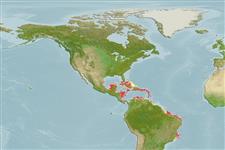Common names from other countries
>
Anguilliformes (Eels and morays) >
Ophichthidae (Snake eels) > Ophichthinae
Etymology: Myrichthys: Greek, myros, -ou = male of morey eel + Greek, ichthys = fish (Ref. 45335).
More on author: Lesueur.
Environment: milieu / climate zone / depth range / distribution range
Ecologia
marinhas associadas(os) a recifes; intervalo de profundidade ? - 15 m (Ref. 58018). Tropical; 25°N - 23°S
Western Atlantic: Bermuda, southern Florida (USA), and Bahamas to Santa Catarina, Brazil (Ref. 57756). Eastern Atlantic.
Tamanho / Peso / Idade
Maturity: Lm ? range ? - ? cm
Max length : 110 cm TL macho/indeterminado; (Ref. 26938)
With diffuse dark spots, each with a pale center (bright yellow in life), on a pale tan or greenish-brown background, shading to pale green ventrally (Ref. 26938).
Common near islands and in rocky or coral areas (Ref. 7251). May move beneath the sand (Ref. 9710). Found in seagrass bed sand areas with sand and coral rubble (Ref. 26938). Feeds mainly on crabs (Ref. 32). Forages at night for prey.
Ciclo de vida ou comportamento de acasalamento
Maturities | Reprodução | Spawnings | Egg(s) | Fecundities | Larvas
Robins, C.R., R.M. Bailey, C.E. Bond, J.R. Brooker, E.A. Lachner, R.N. Lea and W.B. Scott, 1991. Common and scientific names of fishes from the United States and Canada. Am. Fish. Soc. Spec. Publ. (20):183 p. (Ref. 3814)
Status na Lista Vermelha da UICN (Ref. 130435)
CITES (Ref. 128078)
Not Evaluated
Ameaça para os humanos
Harmless
Uso pelos humanos
Pescarias: espécies comerciais; Aquário: Espécies comerciais
Ferramentas
Relatórios especiais
Baixar XML
Fontes da internet
Estimates based on models
Preferred temperature (Ref.
115969): 26.5 - 28.2, mean 27.5 (based on 632 cells).
Índice de diversidade filogenética (Ref.
82804): PD
50 = 0.5005 [Uniqueness, from 0.5 = low to 2.0 = high].
Bayesian length-weight: a=0.00089 (0.00039 - 0.00204), b=3.00 (2.80 - 3.20), in cm Total Length, based on LWR estimates for this (Sub)family-body shape (Ref.
93245).
Nível Trófico (Ref.
69278): 3.6 ±0.4 se; based on diet studies.
Resiliência (Ref.
120179): médio(a), tempo mínimo de duplicação da população 1,4 - 4,4 anos (Preliminary K or Fecundity.).
Fishing Vulnerability (Ref.
59153): High to very high vulnerability (66 of 100).
